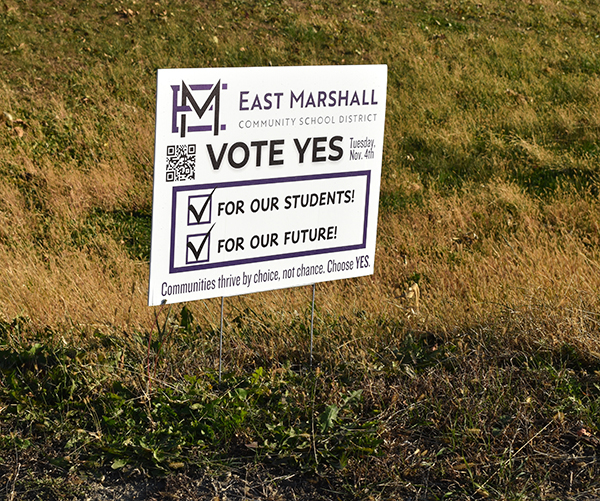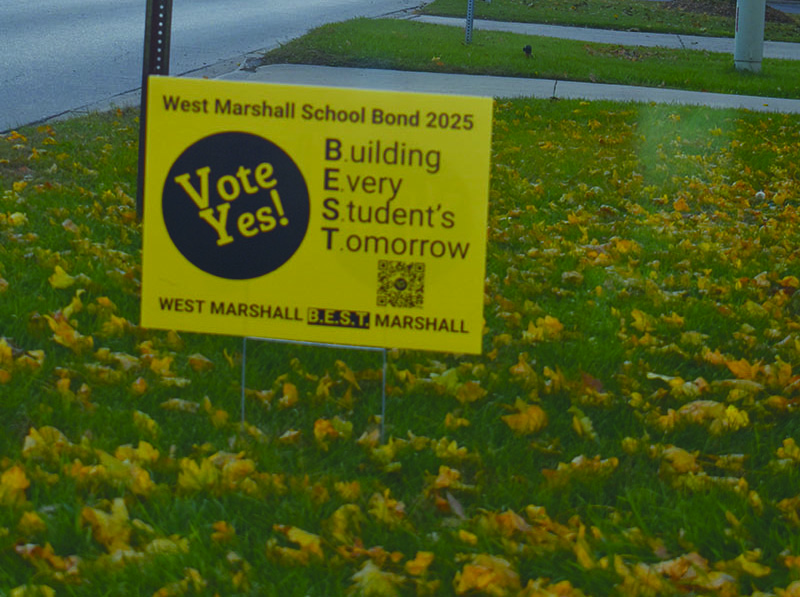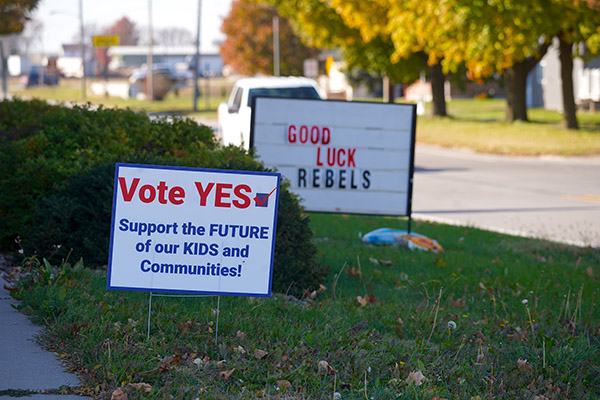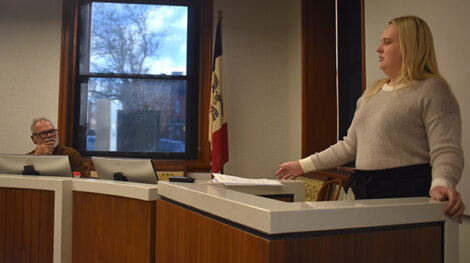East Marshall, West Marshall, G-R bond issues all pass on repeat attempts

T-R PHOTO BY ROBERT MAHARRY — Vote Yes’ East Marshall yard signs like the one pictured were placed at properties around the district in the lead up to Tuesday’s successful $19.8 million bond referendum, which received 69 percent support on the first question and 67 percent on the second.
AREA — Three area school districts will see major improvements to their facilities now that bond referendums at East Marshall, West Marshall and Gladbrook-Reinbeck all surpassed the necessary 60 percent supermajority of votes in elections held Tuesday — and after each had previously failed at least once before.
East Marshall’s swing from a failed $13.5 million bond referendum in 2024 to a successful $19.8 million bond in 2025 was the most pronounced. Last fall, it received just 53.5 percent support, but this year, with two questions and the maximum $4.05 per $1,000 of property valuation on the ballot, the first question received 69 percent support (780 out of 1,130 votes cast) across the district’s territories in Marshall, Tama, Poweshiek and Jasper counties, while the second question received 67 percent support (756 out of 1,128 votes cast).
First year East Marshall Superintendent Kevin Seney took the job knowing that addressing facilities and leading the charge on another bond issue would essentially begin on day one in his new position, and he was excited to get to work.
“I think, obviously, it means that the communities are invested in the school district, and we hope that we made that connection about (the fact that) strong schools equal strong communities, that there is a reciprocal relationship between the health of the school district and the health of our communities,” he said. “And I feel like folks that came out and voted and supported this initiative really understood it, which was great. I also felt like, this time around too, we had an outstanding group of Yes Committee community members who really advocated this in all the ways they knew how to advocate for it — personal face-to-face conversations, putting up yard signs, putting together a Facebook page, just being absolutely outstanding ambassadors for this effort. Not only does it show the commitment by the communities but also the real-life supporters of this who have kids that go here and who want to see East Marshall survive and thrive into the future. Just seeing them so committed was outstanding.”
After the failure of the bond in 2024 and controversy surrounding the impending closure of the Gilman building currently housing grades 6-8, Seney acknowledged the risk of pursuing a larger dollar amount — the maximum allowed under Iowa law — but he felt that during the previous cycle, district leaders were afraid of asking for what they needed including provisions like a more efficient HVAC system. This bond, Seney said, went beyond a Band-Aid approach to position East Marshall for the future, comparing it to buying a used car for $10,000 as opposed to a certified pre-owned vehicle for $5,000 more with the assurance that it would last the driver 10 to 15 years longer.
Most people knew about the exterior conditions of the district’s three current buildings, he said, but tours allowed voters to see boiler rooms with fixtures with no replacement parts and no repairmen in the state who still work on them.
“Just being really open and really transparent with people about what our needs actually are, I think that helped us actually make the case rather than shy away from it,” Seney said.
While the bond will primarily finance improvements and expansions at the elementary building in Laurel and the high school in Le Grand to eventually make East Marshall a district with two attendance centers, it also provides options for the future of the Gilman center including renovating the gymnasium and moving the administrative offices there from the separate building where it is currently housed.
“I think that was a risk that paid off, for sure, but I also think, too, that still having a school district presence in Gilman, still maintaining that we are a school district of three or four communities and that we have to make sure that we’re gonna do everything we can to keep a presence in each one of those communities,” he said. “We know that having a presence there, keeping some semblance of the district within that community, it means a lot to the residents there. So I think that was helpful, and I think it also gives us options in the future, to do some different kinds of programming even for kids in Gilman that we hadn’t thought of before.”
Additionally, he said that if space in Le Grand can be renovated for Career and Technical Education (CTE) offerings, the school board will consider building an addition in Gilman dedicated specifically to wrestling with Securing an Advanced Vision for Education (SAVE) dollars, which are separate from General Obligation (GO) bonds.
Now that the bond has passed, Seney and the school board will look to engage with a construction management firm to review plans and designs with architects before putting the project out for bid, and the tentative timeline is to have students occupying the new spaces within three years. The Gilman building is slated to close as an attendance center by the end of the 2026-2027 school year unless a facilities assessment determines that it should happen sooner.
Seney interpreted the results both at East Marshall and in other nearby rural districts as a positive sign that the people who live inside of them are committed to ensuring their future viability — even if it means paying more property taxes to do so.
“Looking across the landscape of small Iowa rural communities in the past 10, 15, 20 years and just seeing what’s happened to some of those small towns when they lose their school or lose their district, and their families are forced to go to bigger schools on the cusp of their district like Marshalltown or Newton or Grinnell or South Tama, I think you still want to keep whatever identity you can as a community and as a school district,” he said. “When you think about the risk of loss — like, hey, this could cost me a few more dollars in taxes per year — but on the flip side of that, if we have nothing here and no place for kids to go, we start to dry up and blow away as a community. So I think that’s the message that these small districts are sending is that we’re committed, we have the fight left in us, we have the resources, and we want to keep our schools for as long as we possibly can in our communities.”

T-R PHOTO BY ROBERT MAHARRY —
A ‘Vote Yes’ sign for the West Marshall bond referendum is shown in State Center. The bond passed with 62.6 percent support on Tuesday.
West Marshall
Last November, West Marshall’s $14 million bond issue, which will be paired with $7 million in SAVE funds toward various improvements including the construction and furnishing of a new two-story K-5 building at the elementary, an addition connecting the middle and high school buildings with a new Career and Technical Education (CTE) space for students and a new drop off and parking area at the elementary school, fell just short of the required 60 percent supermajority with 56 percent support. It was also competing against a successful city of State Center bond for a new fire station, and this time around, it cleared the threshold with 837 out of the 1,337 votes cast in favor (62.6 percent) across Marshall and Story counties. Unlike its fellow directional Marshall County school, all of West Marshall’s current facilities are located within one community — State Center.
Superintendent Jacy Large, an alumni of the district himself, felt confident about the chance to pass the bond in 2025 and set a goal of reaching 40 percent participation among the roughly 3,300 registered West Marshall voters. It was accomplished. Given the district’s strong numbers in Iowa’s annual School Performance Profiles, he cited improved facilities as “the final piece of the puzzle” toward attracting students and keeping high-quality teachers who get involved in the community and make an impact in the lives of their students.
Because so many bond issues passed on Tuesday night, Large did note that finding qualified contractors could become more of a challenge in the months to come.
“It’s a steep climb, and sometimes there’s zero guardrails at this point. But we’ll go in at the end of November and work with Ahlers (and Cooney) on our bond sales and receipts to try to get the bonds committed. And then from that, we’ll start working within our development and design, that tandem, with architects, and then decide on the bid package of what actually is gonna be inside the walls that we build,” he said. “And then we hope, when we reach those bid packages, that we get bids that we need to be able to fit within our approximate budget of $19.2 (million), and then we have a cap at $21 million.”
The goal is to have the project completed within two years, and Large echoed Seney’s comments about the importance of investing in smaller rural districts to maintain and bolster the identities of the communities that comprise them well into the future.

T-R PHOTO BY RUBY F. MCALLISTER —
A yard sign in support of G-R’s $17.3 million bond referendum pictured in front of Reinbeck Country Foods on Tuesday. Behind the sign, another sign in support of the state-bound Rebel volleyball team is also visible. The bond passed by a mere 16 votes, garnering 60.86% support.
Gladbrook-Reinbeck
On its third try in four years, Gladbrook-Reinbeck has finally passed a school bond referendum.
A mere 16 votes coupled with an unprecedented turnout in Grundy County for a school election pushed the district’s $17.3 million general obligation bond referendum into the required 60% supermajority territory on Tuesday.
“My initial response would be … speechless,” G-R Superintendent Caleb Bonjour told the newspaper late Tuesday evening by text message shortly after he learned that the bond had passed. “I am just proud of the work that has been done and the conversations that have been started… The bond may have passed but we have a lot of work left to do to keep building the strength of our WHOLE school district. I keep reminding myself that this work is a marathon and not a sprint. As a district we have to keep running the race and ensuring that everyone is a part of the effort!”
Last November, the district’s $16.5 million bond request failed, falling short of a supermajority by garnering roughly 50% of the vote with 1,235 voting in favor and 1,203 voting against. In September 2022, a $23.6 million bond referendum failed to pass as well.
Unofficial results show the 2025 bond passed with 60.86% support – 1,177 voting in favor and 757 voting against.
In Grundy County (including Reinbeck), 927 votes were cast in favor of the bond’s public measure with only 83 against, equating to nearly 91.8% approval. The opposite could be said for voters in Tama County, where support for the bond appeared less than enthusiastic with 198 (~23.2%) voting in favor and 654 (~76.8%) voting against.
In Gladbrook specifically, 88.4% of voters (525 votes) came out against the bond with 69 votes cast in support. Lincoln split more evenly with 128 voting ‘yes’ and 129 voting ‘no.’
In Black Hawk County, 49 votes were cast in favor and eight against. In Marshall County, three votes were cast in favor with 12 against.
As election day neared, tension reached a fever pitch across the district, particularly on social media, where a war of sorts played out between those in favor and those against the bond. In the summer of 2022, the entire Gladbrook campus was demolished leaving no local school infrastructure in the community. In the years since, the district has brought back public preschool classes in Gladbrook in partnership with Crayon Corner Learning Center.
According to the district, with the bond’s passage, the following will be addressed at the junior high/high school building in Reinbeck:
-Build a secure-entry classroom addition to improve safety and replace outdated learning spaces
-Address ADA-compliance and accessibility issues
-Complete HVAC system upgrades for safety, comfort and efficiency
-Improve electrical systems to support learning technology
-Replace deteriorating infrastructure from the 1921 building
-Create flexible, functional academic spaces to support student learning and future programming
In the wake of unofficial results Tuesday evening, the district’s 2025 referendum website was updated with the following statement from Bonjour.
“We are truly grateful for our community’s support of this important project. The improvements approved in this referendum will address essential facility needs – such as ADA accessibility, HVAC and electrical upgrades, and secure learning spaces – while ensuring our schools remain safe, efficient, and supportive for all students. This is an incredible step forward for our district,” he wrote. “The district extends its sincere thanks to all residents who took time to learn about the plan, attend meetings, ask questions, and participate in the voting process. The success of this referendum reflects a shared commitment to investing in our students, our schools, and the future of the Gladbrook-Reinbeck community. Next steps include continued collaboration with the district’s project partner to finalize design and construction timelines. The district will continue to keep the community informed as work progresses.”
The Tama County Board of Supervisors will canvass election results on Wednesday, Nov. 12, at 9 a.m. at the Tama County Administration Building in Toledo; a final canvass is set to be completed by Tama County on Monday, Nov. 17.





